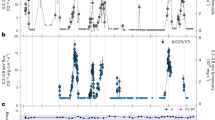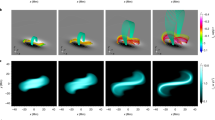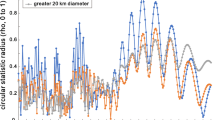Abstract
Replying to: R. S. J. Sparks, R. J. Brown, M. Field & M. Gilbertson Nature 450, 10.1038/nature06435 (2007)
Differences between the model of Sparks et al.1,2 and ours3 arise mainly because we focus on phenomena during the transient, opening phase that we suggest dominates many kimberlite eruptions, rather than on the subsequent, more prolonged phases relevant to other kimberlite eruptions1,2.
Similar content being viewed by others
Main
If water dominates carbon dioxide (CO2) as the vapour phase1,2, our argument3 about the pressure distribution driving a kimberlite dyke to the surface is reinforced. The key factor allowing the initial rapid ascent is the large difference between the high mantle source pressure and the low dyke tip pressure, the latter being buffered by the saturation pressure of the least soluble volatile phase4,5. The dyke tip pressure required for water to exsolve will be even lower than the pressure we inferred for CO2, thus increasing the pressure difference driving the magma upward through the opening dyke.
Any vapour-filled region at the tip of a dyke, breaking away to propagate faster as an independent crack, can incorporate6 some of the magmatic foam implied by our model3. Cracks longer than ∼20 m travel at ∼1 km s-1, which is ∼40% of the sound speed in rock7. Chilling of magma in the closing crack base ‘heals’ the fracture, restoring the country rock mechanical properties. When the dyke tip subsequently arrives, it encounters essentially the same conditions as if crack separation had never occurred. Only seconds are needed to chill a 1–2-mm-thick film of magma left behind by a ∼20-m-long crack; during this time the dyke tip, rising3 at ∼20 m s-1, travels ∼100 m—a tiny fraction of the dyke’s vertical extent. A new low-pressure region starts to grow below the dyke tip immediately after crack separation; we infer that the stress and pressure conditions we proposed will be present over most of the path of the rising dyke tip.
Our dyke geometries are only slightly larger than those of Sparks et al.1,2, and their minimum estimates of total magma volumes imply eruption durations only a few times longer than the time to establish the dyke pathway3; larger volumes will imply more prolonged events. Our calculations3 of adiabatic cooling refer to magma reaching the surface during the opening phase of an eruption; in a long-lived eruption, most of the magma finally emplaced in the sub-surface diatreme will indeed suffer less cooling.
We suggested3 a violent change from overpressure to underpressure as a dyke reached the surface, with rapid physical development of the near-surface pipe and diatreme system. A longer-lived eruption1,2 will indeed allow a range of additional failure mechanisms. Although ‘fluidization’ commonly relates to the near-steady passage of gas through unconsolidated granular materials, as in the waning phases of kimberlite eruptions8, the basic physics is the same as that in our violent opening phase.
Regarding preservation of diamonds during transit to the surface, we stress3 that rapid transport will maximise the survival of diamonds as they pass through potentially unstable combinations of ambient pressure and temperature conditions, irrespective of the chemical environment that they encounter9.
References
Sparks, R. S. J. et al. Dynamics of kimberlite volcanism. J. Volcanol. Geotherm. Res. 155, 18–48 (2006)
Sparks, R. S. J., Brown, R. J., Field, M. & Gilbertson, M. Kimberlite ascent and eruption. Nature 450 10.1038/nature06435 (2007)
Wilson, L. & Head, J. W. An integrated model of kimberlite ascent and eruption. Nature 447, 53–57 (2007)
Lister, J. R. & Kerr, R. C. Fluid-mechanical models of crack propagation and their application to magma transport in dykes. J. Geophys. Res. 96, 10049–10077 (1991)
Rubin, A. M. Dikes vs. diapirs in viscoelastic rock. Earth Planet. Sci. Lett. 119, 641–659 (1993)
Menand, T. & Tait, S. R. A phenomenological model for precursor volcanic eruptions. Nature 411, 678–680 (2001)
Dobran, F. Volcanic Processes — Mechanisms in Material Transport page 212 (Kluwer/Plenum, New York, 2001)
Walters, A. L. et al. The role of fluidisation in the formation of volcaniclastic kimberlite: grain size observations and experimental investigation. J. Volcanol. Geotherm. Res. 155, 119–137 (2006)
Ross, J. et al. (eds) Kimberlites and related rocks: their mantle/crust setting, diamonds and diamond exploration. Proceedings of the Fourth International Kimberlite Conference. Geol. Soc. Australia Special Publication, 14, 935–965 990–1000 (Perth, Australia, 1989)
Author information
Authors and Affiliations
Rights and permissions
About this article
Cite this article
Wilson, L., Head III, J. Wilson & Head reply . Nature 450, E22 (2007). https://doi.org/10.1038/nature06436
Issue Date:
DOI: https://doi.org/10.1038/nature06436
This article is cited by
-
Hydrovolcanic activity on a continental shelf inferred from the subsurface diatreme- and crater-filling deposits of Jeju Island, Korea
Bulletin of Volcanology (2022)
-
Early volcanological research in the Vulkaneifel, Germany, the classic region of maar–diatreme volcanoes: the years 1774–1865
Bulletin of Volcanology (2013)
-
Deadly divide: Malawi’s policy debate on HIV/AIDS and condoms
Policy Sciences (2011)
Comments
By submitting a comment you agree to abide by our Terms and Community Guidelines. If you find something abusive or that does not comply with our terms or guidelines please flag it as inappropriate.



